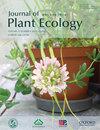高山植物的花表面中心比边缘更温暖:来自青藏高原的证据
IF 3.9
2区 环境科学与生态学
Q2 ECOLOGY
引用次数: 0
摘要
尽管花的温度在植物繁殖中起着重要作用,但它在花表面的空间变化尚不清楚,尤其是在高山植物中。为了表征花表面温度的空间变化,我们在青藏高原东北部冷龙山3200至4000m的一个海拔剖面上对18种花的热图像进行了研究。在阳光照射下,所有植物的花或花单元内的表面温度变化很大,约为1℃,中心的最高温度比边缘高11℃。太阳辐射和花朵形状显著影响温度范围和标准差以及花朵中心与边缘温度的比值。温度的空间变异性随着花的大小而增加。菊科的花朵表面温度更高,温度的空间变异性更大,中心的温度始终比边缘更高、更稳定。大多数品种的花中心与边缘温度的比值随海拔高度的增加而增加。花中心的热量积累可能在高山植物中广泛存在;需要进一步的研究来探索其生态和进化作用。本文章由计算机程序翻译,如有差异,请以英文原文为准。
Flower surface is warmer in center than at edges in alpine plants: evidence from Qinghai-Tibetan Plateau
Although flower temperature plays an important role in plant reproduction, how it varies spatially on the flower surface is unclear, especially in alpine plants. To characterize spatial variation in flower surface temperature, we examined thermal images of flowers of 18 species along an altitudinal transect from 3200 to 4000 m on Lenglong Mountain on the north-eastern Qinghai-Tibetan Plateau. The surface temperature varied considerably within a flower or floral unit in all plants under sunlight, and was about 1 ℃ with a maximum of 11 ℃ higher in the center than at the edges. Solar radiation and flower shape significantly affected the temperature range and standard deviation and the ratio of flower center to edge temperature. The spatial variability of temperature increased with flower size. Flowers in the Asteraceae had higher surface temperatures, greater spatial variability of temperature, and consistently higher and more stable temperatures in the center than at the edge. The ratio of flower center to edge temperature increased with altitude in most species. Heat build-up at the flower center is likely to be widespread in alpine plants; further studies are needed to explore its ecological and evolutional roles.
求助全文
通过发布文献求助,成功后即可免费获取论文全文。
去求助
来源期刊

Journal of Plant Ecology
生物-植物科学
CiteScore
4.60
自引率
18.50%
发文量
134
审稿时长
3 months
期刊介绍:
Journal of Plant Ecology (JPE) serves as an important medium for ecologists to present research findings and discuss challenging issues in the broad field of plants and their interactions with biotic and abiotic environment. The JPE will cover all aspects of plant ecology, including plant ecophysiology, population ecology, community ecology, ecosystem ecology and landscape ecology as well as conservation ecology, evolutionary ecology, and theoretical ecology.
 求助内容:
求助内容: 应助结果提醒方式:
应助结果提醒方式:


